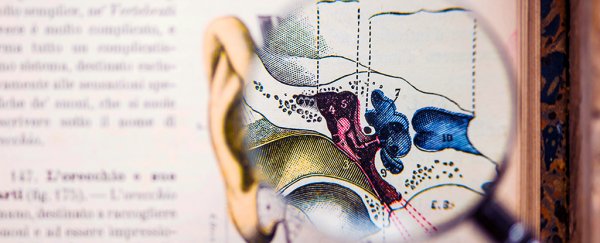Nerves that carry information from the inner ear to the brain were assumed to come primarily in two forms, called type I and type II nerves. But now an analysis of the RNA of each of these cell types in mice has revealed one of those cells isn't as it seems.
It turns out that type I nerves actually represent three different nerve types that are completely new to science. Understanding their characteristics could help us better model how mammals perceive sounds, and maybe even lead to better treatments for hearing disorders.
Researchers at Karolinska Institutet in Sweden set out to detail the complex pathway of cellular and chemical changes that communicate a mess of noisy signals from the cochlear to the brain.
We're all fairly familiar with the textbook explanation of our hearing; sound waves shake a membrane in our middle ear called the eardrum, which in turn shakes a trio of tiny bones connected to a spiralling tunnel of fluid called the cochlea.
These concentrated pressure waves make beds of microscopic hairs bend like fields of grass rippling in the wind, producing cellular distortions that are transformed into chemical signals by nerve cells.
While this is as detailed as most of us need to know, neuroscientists are keen to map this whole communication process down to a molecular level in order to better understand how waves in the air transform into symphonies of birdsong in our minds.
So, the more accurate term for those nerve cells is spiral ganglion neurons. Roughly 88 percent of them are referred to as type I. These have protective myelin sheaths wrapping their long 'axon' tails, and send signals down a one-way street.
In contrast there are a small number of spiral ganglion cells without the protective sheaths, and can send signals in two directions. They're the ones called type II.
Each performs slightly different roles in the hearing process, connecting to different groupings of cochlear hairs and operating in slightly different ways.
While it's broadly understood how separate bundles of hair cells and these two types of spiral ganglion process a myriad of frequencies and intensities for interpretation by the brain, the cellular basis of these calculations are still vague.
That's why Karolinska Institutet neurologists went further than simply studying the shapes and chemical make-up of these cells.
They also sequenced the RNA from individual cells extracted from mice, giving them a record of genetic activity that could in turn be used to describe a story of biochemical responses.
It turns out type I isn't just one type after all.
"We now know that there are three different routes into the central auditory system, instead of just one," says the study's group leader, François Lallemend.
Each of these four spiral ganglion neurons – type Ia, Ib, Ic, and type II – were found to be already doing their job when extracted from mice pups shortly after birth, suggesting they're not the result of environmental changes.
Keeping in mind the work was carried out only in mice so far, the research has enormous implications for developing a comprehensive explanation for auditory processing in humans, since the auditory systems are so similar.
Type II, for example, seems to respond to stress in the ear. This makes sense, given it's a two-way street – the cells can respond to loud noises by affecting the cells they're connected to, potentially offering some sort of protection.
As for those different sub-classes of type I neuron, each could be responsible for tuning into different thresholds of noise, helping us filter out different intensities in noisy environments.
Identifying this distinction at a cellular level might help us develop better models for hearing conditions such as tinnitus, or disorders that make us oversensitive to certain sounds, such as hyperacusis.
"Once we know which neurons cause hyperacusis we'll be able to start investigating new therapies to protect or repair them," says Lallemend.
"The next step is to show what effect these individual nerve cells have on the auditory system, which can lead to the development of better auditory aids such as cochlear implants."
Genetic tools such as RNA sequencing of individual cells is allowing researchers to identify a whole range of new cell types in the body just as microscopes did centuries ago.
It's almost certain that many cells in the body that look similar could in fact represent functionally different tissues. Finding them will give us an unprecedented level of understanding of health and disease.
No doubt, there is plenty more left to discover.
This research was published in Nature.
